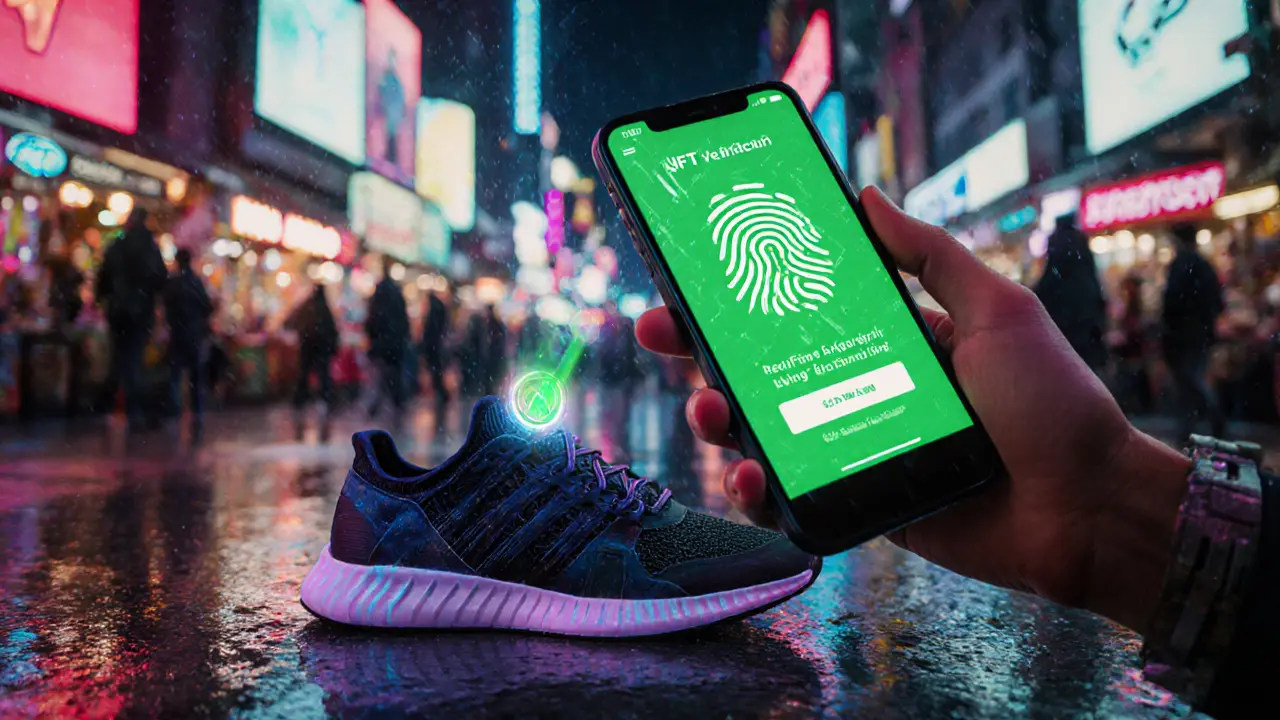NFT Anti-Counterfeiting Comparison Tool
NFT-Based System
A blockchain-based certificate that follows a product from factory to consumer, instantly proving authenticity through immutable records.
Immutable Traceable Unique AutomatedTraditional Approach
Paper certificates or physical tags that can be forged, destroyed, or manually tampered with during the supply chain process.
Manual Verification Vulnerable to Forgery Limited Traceability| Feature | NFT-Based System | Traditional Approach |
|---|---|---|
| Immutability | Ledger entries cannot be altered once confirmed | Paper certificates can be forged or destroyed |
| Traceability | Every transfer recorded, viewable by anyone | Manual logs often incomplete, prone to error |
| Uniqueness | Cryptographic token ID guarantees one-to-one mapping | Serial numbers can be duplicated |
| Automation | Smart contracts enforce rules instantly | Human verification needed for each checkpoint |
| Physical Protection | Requires hybrid tag; blockchain alone can't stop a fake product | Holograms, watermarks, RFID provide direct physical security |
| Cost Over Time | Higher upfront tech spend, lower ongoing verification fees | Lower start-up cost, higher labor and audit expenses |
NFTs offer several advantages over traditional methods:
- Immutability: Once recorded, data cannot be changed, ensuring authenticity.
- Traceability: Every step in the supply chain is documented and verifiable.
- Uniqueness: Each token has a unique cryptographic identity, preventing duplication.
- Automation: Smart contracts handle verification automatically without human intervention.
- Interoperability: Tokens can be verified across different systems and platforms.
While NFTs provide superior digital proof, they work best when combined with physical security measures like holograms or fingerprints to create a hybrid solution.
Quick Takeaways
- NFT anti‑counterfeiting creates a tamper‑proof digital certificate that lives on a blockchain.
- Immutability, traceability and uniqueness make forgery extremely difficult.
- Hybrid solutions combine NFTs with physical tags (fingerprinting, holograms) for the best protection.
- Implementation needs blockchain infrastructure, smart‑contract development and supply‑chain integration.
- Compared with traditional methods, NFTs lower long‑term verification costs but demand technical expertise.
When counterfeit goods flood the market-an estimated $1.82trillion in 2019 alone-businesses need a proof system that can’t be copied, erased or altered. Anti‑Counterfeiting with NFT Technology offers exactly that: a blockchain‑based certificate that follows a product from factory to consumer, instantly proving who really owns it.
NFT anti‑counterfeiting system is a digital token minted on a blockchain that links a unique identifier to a physical or digital item, creating an immutable record of authenticity. The token lives on a public ledger, so anyone can verify its status without contacting the manufacturer. Because each token is unique, forged copies have no corresponding entry on the chain and are instantly flagged as fake.
Core Technical Building Blocks
Blockchain is a decentralized ledger that records transactions in cryptographically linked blocks, making past data immutable provides the foundation. On top of that, three additional components turn a simple ledger into an anti‑counterfeiting powerhouse:
- Smart contracts are self‑executing code that enforces verification rules without human intervention. They can automatically reject a transfer if the token’s provenance shows a break in the supply chain.
- Cryptographic keys use public‑private key pairs to prove ownership; only the holder of the private key can sign a transaction. This prevents unauthorized minting or transfer.
- Product passport is the digital representation of a physical item, containing metadata such as origin, material, and batch number. The passport lives inside the NFT and can be read with a QR code or NFC tag attached to the product.
The combination of immutability, traceability, uniqueness, automation and interoperability is what separates NFTs from traditional paper certificates.
Step‑by‑Step: Building an NFT Anti‑Counterfeiting Solution
- Pick a blockchain. Public chains like Ethereum offer broad adoption; private/consortium chains (e.g., Hyperledger) reduce gas fees and increase privacy.
- Design the token schema. Include fields for serial number, manufacturing date, and a link to a physical tag identifier (e.g., fingerprint hash).
- Write the smart contract. Use Solidity or Rust to code minting, transfer, and verification functions. Include a “revoke” method for recalled items.
- Integrate with the supply chain. Connect the contract to an ERP system so every step-assembly, packaging, distribution-triggers a blockchain event.
- Attach a physical authentication layer. Apply a fingerprinting pattern, hologram, or NFC tag that stores the same hash used in the NFT. This hybrid link stops counterfeiters from copying the token alone.
- Deploy a verification app. Build a mobile scanner that reads the physical tag, fetches the NFT data, and displays a green check if the record matches.
Typical skill sets required include blockchain development, cryptography, and supply‑chain engineering. A small pilot-authenticating a luxury watch line, for example-can be built in 4‑6 weeks with a dedicated team.

Traditional vs. NFT‑Based Anti‑Counterfeiting
| Feature | NFT‑Based System | Traditional Approach |
|---|---|---|
| Immutability | Ledger entries cannot be altered once confirmed | Paper certificates can be forged or destroyed |
| Traceability | Every transfer recorded, viewable by anyone | Manual logs often incomplete, prone to error |
| Uniqueness | Cryptographic token ID guarantees one‑to‑one mapping | Serial numbers can be duplicated |
| Automation | Smart contracts enforce rules instantly | Human verification needed for each checkpoint |
| Physical protection | Requires hybrid tag; blockchain alone can’t stop a fake product | Holograms, watermarks, RFID provide direct physical security |
| Cost over time | Higher upfront tech spend, lower ongoing verification fees | Lower start‑up cost, higher labor and audit expenses |
The table shows why many brands are moving to NFTs: long‑term transparency and low verification costs. Still, the “Physical protection” row reminds us that a token alone isn’t enough for a sealed bottle of medicine or a leather bag.
Real‑World Use Cases Across Industries
Luxury goods brands such as high‑end fashion houses use NFT passports to certify handbags, watches, and artwork and let buyers scan a QR code to see the full provenance. In the pharmaceutical sector, manufacturers mint NFTs for each drug batch, linking it to a tamper‑evident hologram on the packaging. Pharmacists can verify authenticity before dispensing, dramatically reducing counterfeit circulation.
Automakers are experimenting with digital certificates for VIN numbers. Each vehicle receives an NFT that records ownership changes, service history, and recall status. Governments are testing NFT‑based property titles to curb land‑title fraud.
Marketplace platforms like OpenSea provide takedown mechanisms for infringing NFTs, helping brands protect their trademarks online have become a de‑facto verification hub. However, smaller marketplaces often lack robust enforcement, leaving gaps in the protection chain.
Challenges, Pitfalls, and Best Practices
Even with blockchain’s strengths, several hurdles can trip up a rollout:
- Technical complexity. Teams need seasoned blockchain developers; hiring errors increase costs.
- Physical‑digital split. Without a reliable tag (fingerprint or NFC), counterfeiters can copy the look of a product while the NFT remains untouched.
- Consumer adoption. End users must understand how to scan and interpret an NFT certificate; simple UI/UX is vital.
- Regulatory uncertainty. Laws around digital assets vary; legal counsel should review token ownership clauses.
Best‑practice checklist:
- Start with a pilot on a high‑value SKU.
- Choose a blockchain that balances security and transaction cost.
- Pair each NFT with a tamper‑proof physical tag; store the tag’s hash inside the token.
- Build a mobile verification flow that works offline (cache the latest blockchain snapshot).
- Document governance: who can mint, who can revoke, and how disputes are resolved.
Future Outlook: From Static Tokens to Dynamic Passports
Next‑gen solutions are moving beyond a single‑use token. Dynamic NFTs can update metadata over time, allowing a product passport to reflect repairs, upgrades, or recycling status while preserving the original proof of origin. This opens doors for circular‑economy models where a car’s battery can be tracked from manufacture to second‑life reuse.
Virtual‑reality (VR) environments are also adopting NFTs for brand assets. Experts warn that as digital twins proliferate, trademark owners will face new infringement vectors, making robust token enforcement even more critical.
Standardization bodies are drafting interoperable token schemas, meaning a watch authenticated on one blockchain could be verified on another platform without custom adapters. When those standards land, adoption will accelerate across fashion, pharma, automotive, and even government IDs.

Frequently Asked Questions
How does an NFT prove a product is genuine?
When a product is manufactured, a unique token is minted on a blockchain and linked to a physical tag. The token contains immutable data-serial number, origin, and a cryptographic hash of the tag. Scanning the tag pulls the NFT data; if the hash matches and the token’s ownership chain is intact, the product is authentic.
Can NFTs stop a counterfeit physical item from being produced?
Not on their own. NFTs secure the digital record, but a fake physical item can still be made. The most effective defense combines the NFT with a tamper‑proof physical tag-such as laser‑etched fingerprints or holograms-so a counterfeit lacks the matching digital proof.
What blockchain should I use for a supply‑chain pilot?
Public chains like Ethereum offer security and wide tooling, but gas fees can be high. Private consortium chains (Hyperledger Fabric, Quorum) give you control over costs and privacy while still delivering immutability. Pick the one that matches your volume and compliance needs.
How expensive is it to mint an NFT for each product?
Minting costs vary by chain. On Ethereum, a single mint can be $10‑$30 in gas; on low‑cost chains like Polygon it drops to cents. Bulk minting and layer‑2 solutions can further reduce the price, making large‑scale rollout financially viable.
Do I need legal counsel to issue NFTs for my products?
Yes. NFT ownership, licensing, and data‑privacy rules differ across jurisdictions. A lawyer can help draft smart‑contract terms, address consumer rights, and ensure compliance with emerging digital‑asset regulations.
In short, NFTs bring blockchain’s trust engine to the world of product authentication. Pair them with solid physical tags, plan the tech rollout carefully, and you’ll give counterfeiters a lot less room to hide.

Ben Dwyer
November 17, 2024 AT 04:08Great overview of how NFTs can tighten up product authentication. The immutable ledger really does give brands a solid line of defense against fakes, especially when paired with a physical tag. Keep pushing forward with pilots; the data you gather will be invaluable for scaling.
Oreoluwa Towoju
November 24, 2024 AT 10:32Nice summary, and it really hits the core points without overcomplicating things. The blend of digital and physical security feels inclusive for both makers and buyers.
Amie Wilensky
December 1, 2024 AT 16:56One might argue that the allure of NFTs lies less in their technical merit and more in the narrative they construct; indeed, a token is merely a string of data-yet, when that string is bound to a physical artifact, the philosophical divide between "real" and "digital" begins to blur, doesn’t it?; moreover, the very act of immutable recording forces us to confront the temporality of trust in commerce-an immutable ledger does not just store facts, it reshapes perception.
Katrinka Scribner
December 8, 2024 AT 23:20Wow, this is sooo helpful!! I totally love how you broke it down-feels like a friendly chat over coffee ☕️. Even if I'm not a tech whiz, the idea of scanning a tag and getting a green check is super clear. Keep the good vibes coming!!
april harper
December 16, 2024 AT 05:44The promise of a tamper‑proof digital passport is almost poetic, yet the reality still hinges on the frailty of the physical world.
Clint Barnett
December 23, 2024 AT 12:08When you think about integrating NFTs into a supply‑chain, the first thing that comes to mind is the sheer breadth of collaboration required across departments. The engineering team must design a robust smart contract that can handle millions of transactions without choking, while the operations crew needs to embed QR‑codes or NFC chips seamlessly into packaging. Legal counsel will have to draft clear terms of service that address ownership transfer, especially in cases of resale or recall. Marketing, on the other hand, can leverage the story of provenance to justify premium pricing and build brand loyalty.
Data analysts will love the granular traceability, as each checkpoint becomes a data point that can be visualized in real‑time dashboards. Customer support teams will benefit from reduced fraud tickets because a simple scan validates authenticity instantly.
Moreover, the cost model shifts dramatically: upfront investment in blockchain infrastructure, token minting, and tag production can be substantial, but verification costs per unit plummet once the system is live.
In the long term, you also gain an immutable audit trail useful for regulatory compliance, especially in pharmaceuticals where traceability is mandated.
Of course, the technology is not without challenges-network congestion can drive up gas fees, and onboarding suppliers to a new workflow requires training and incentives.
Nevertheless, the strategic advantage of owning a tamper‑proof digital identity for each product can outweigh the hurdles, particularly for high‑value goods.
Finally, consider future‑proofing: as standards evolve, designing your token schema to be interoperable will save costly migrations later. In essence, the journey is complex, but the potential payoff in brand protection and consumer trust is massive.
Kate Nicholls
December 30, 2024 AT 18:32The comparison chart does a solid job highlighting the strengths of NFT‑based systems, but it glosses over the operational overhead of maintaining a hybrid tag‑and‑token setup. Brands should weigh that against their specific risk profile.
Carl Robertson
January 7, 2025 AT 00:56Honestly, the hype around NFTs feels like a drama episode that keeps getting renewed. The tech is slick, sure, but the real battle is convincing end‑users to actually scan a tag instead of just trusting a logo.
Jason Brittin
January 14, 2025 AT 07:20Cool stuff, though I can’t help but notice how many “future‑proof” promises end up being buzzwords. Still, if the ROI shows up in reduced counterfeit claims, the sarcasm turns into a grin. 😏
VICKIE MALBRUE
January 21, 2025 AT 13:44Love the practical steps; this is exactly what we need.
Naomi Snelling
January 28, 2025 AT 20:08Sure, NFTs sound great until you realize the same corporations pushing them also control the data highways-makes you wonder who's really protected.
Michael Wilkinson
February 5, 2025 AT 02:32While I respect the enthusiasm, let's not forget that aggressive implementation without clear governance can backfire spectacularly; a disciplined rollout is non‑negotiable.
Billy Krzemien
February 12, 2025 AT 08:56The blend of blockchain immutability with a physical authentication tag offers a robust solution; brands that adopt this approach will likely see a measurable drop in counterfeit incidents, provided they invest in user‑friendly verification tools.
Jacob Anderson
February 19, 2025 AT 15:20Oh great, another shiny tech promise that will probably sit on a slide deck forever.
Rajini N
February 26, 2025 AT 21:44In practice, start with a high‑value SKU, choose a low‑cost layer‑2 chain, and pair each NFT with a tamper‑proof hologram. The verification app should cache the latest block data so scans work offline, ensuring a smooth consumer experience.